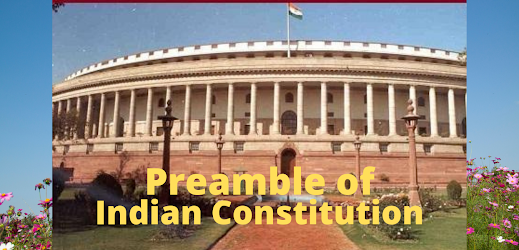Preamble of the Indian Constitution in English: The idea of preamble of the Indian constitution was borrowed from the constitution of USA. The topic on preamble of the constitution of India will help the readers to know about the basic features of the constitution of India and some gk questions may be arise on the competitive exams like ssc cgl, ssc chsl, ntpc, upsc, pscm, nda exams from the topics of preamle of the constitution of india. Short note on preamble of indian constitution is given bellow in details.
⦁ It is a preface or the introduction to the Constitution. It is not an integral part of constitution. The interpretation of constitution is based on the spitit of Preamble.
⦁ The 'Objective Resolution', proposed by Pandit Nehru and passed by the constituent assembly, ultimately became the Peamble. Preamble of the Indian Constitution pdf
The Preamble states:
''WE, THE PEOPLE OF INDIA, have solemnly resolved to constitute India into a SOVEREIGN SOCIALIST SECULAR DEMOCRATIC REPUBLIC and to secure to all citizens: JUSTICE social, economic and political; Liberty of thought, expressin, belief, faith, and worship; EQUALITY of status and of opportunity; and to promote among them all FRATERNITY assuring the dignity of the individual and the unity and integrity of the Nation; in our CONSTITUTENT ASSEMBLY, this teenty-sixth day of November, 1949, do HEREBY ADOPT, ENACT AND GIVE TO OURSELVES THIS CONSTITUTION.''
⦁ The idea of preamble was borrowed from the constitution of USA.
⦁ The words 'SOCIALIST', 'SECULAR' and 'INTEGRITY' were added by the 42nd amendment in 1976.
⦁ Sovereign means free to follow internal and external policies. Socialist means no concentration of power and money. Secular means no particular religion. Democratic means elected representatives. Republic means no room for hereditary ruler or monarch.
⦁ Preamble is not justiciable.
Basic Feature Theory
i) In 1973, in Keshavanand Bharati vs State of Kerala case the Supreme Court held that the Preamble was part of the Constitution and contained its basic structure. The President was not only very much a part of the Constitution, but was of ''extreme importance and the Constitutionshould be read and interpreted in the light of the grand and noble vision expressed in the Preamble''. Any provisions of the Constitution should be amended under Article 368 only ''within the broad contours of the Preamble and of the Constitution''.
ii) The the honorable Supreme Court held that the Basic elements or features of the Constitution as containde in the Preamble cannot be altered by any amended under Article 368. Although the basic elements were not precisely defined, those mentioned in the Preamble were specifically included.
iii) Thus it overruled the Berubari Opinion of its own. (In this case, Preamble was not considered as the part of Constitution).
Nature of the Constitution
Our Constitution is QUASIFEDERAL in nature, designed to work as a UNITARY GOVERNMENT in emergency and FEDERAL GOVERNMENT in normal times.
Federal Features
1. Double seat of Government
2. Division of power
3. Two houses of Parliament
Unitary Features
1. Single Citizenship
2. Single Constitution
3. Single Supreme Court
4. Appointment of Governors
5. Financial dependence of States.
Centre - Supreme Court: At Loggerheads
I. Golaknath Case: In the Golaknath vs. State of Punjab case, the Supreme Court held that the Parliament could not amend the Fundamental Rughts undder Part III of the Constitution. The Parliament on its part, through 24th Amendment in 1971, assumed for itself the power to amend Fundamental Rights.
II. In 1973, the Keshavanand Bharati vs. State of Kerala case happended in which the Basic Fueature Theory was enumerated.
III. 42nd Amendment: Under thijs amendment, the scope of the amending power of the Parliament under Article 368 was extended to many parts of the constitution. Also, the Constitutional Amendments were placed beyond the purview of the Supreme Court's power of Judicial Review.
IV. Menerva Mills Case: In the Minerva Mills case of 1980, the Supreme Court tried to nullify the provisions of the 42nd mendment and held that there could not be any amendment in the basic structure of the Constitution.


0 Comments
Please leave a comment or suggestion